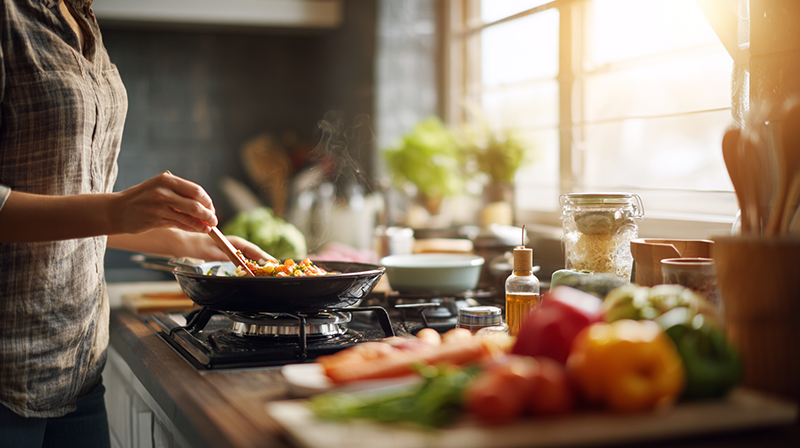Don’t Be Afraid to Cook New Things — Your Kitchen Is a Classroom
- Rex McKee
- Sep 29
- 3 min read

If you’ve been cooking the same meals over and over, it’s easy to fall into a rut. You know the drill: spaghetti on Monday, tacos on Tuesday, grilled chicken again by Wednesday. There’s comfort in routine, but comfort can turn into boredom fast — and boredom is the enemy of creativity and savings in the kitchen.
Trying something new doesn’t have to mean complicated or expensive. In fact, stepping outside your usual recipes can save you money, reduce waste, and make you a more confident cook. Think of your kitchen as a classroom — the stove is your teacher, and every dish you try is a new lesson.
Why We Stick to the Familiar
It’s normal to repeat the same recipes because they’re safe. We know how they taste, how long they take, and which ingredients we need. But there’s a hidden cost: limiting yourself to a small menu can lead to overspending and waste. When you always buy the same things, you might pay more out of convenience or miss great deals on other items.
For example, if chicken breasts are $4.49 a pound and pork shoulder is $1.99, but you don’t know how to cook pork shoulder, you’ll skip it — and skip the savings. Learning one or two new techniques, like slow roasting or shredding, opens the door to cheaper meals and a bigger variety of flavors.
Starting Small Builds Confidence
You don’t have to reinvent your menu overnight. Start with one new recipe or ingredient a week. If you’re used to ground beef tacos, try ground turkey or shredded chicken. If your go-to pasta is spaghetti, experiment with penne or shells and a new sauce.
Here are a few easy, low-risk ideas:
Swap proteins: Try pork chops instead of chicken, or canned salmon instead of canned tuna.
Explore world flavors: Add soy sauce and ginger to stir-fry night, or cumin and smoked paprika to chili.
Play with grains: If you always cook white rice, try brown rice, couscous, or quinoa (especially if it’s on sale).
Expand your veggies: Roast broccoli or Brussels sprouts instead of steaming — roasting makes them sweeter and crispier.
These tiny steps help you build skills and discover what you like — and each success makes the next experiment easier.
Shop Smarter When Trying New Things
Being adventurous doesn’t mean overspending. Keep these tips in mind:
Watch for deals first: Check weekly sales before you plan. If shrimp is on sale, search for easy shrimp recipes.
Buy small amounts: When trying something new, get just enough for one meal. No need to commit to a five-pound bag of barley.
Ask the butcher or produce clerk: They often know the best way to cook unfamiliar cuts or produce — and they like to share advice.
Lean on pantry staples: A new ingredient can be less intimidating when paired with what you already know — add a new sauce to your familiar rice, or a new veggie to your go-to stir-fry.
Learn by Doing (and Failing a Little)
Here’s a truth every great cook knows: failure is part of the process. Some experiments won’t turn out perfect. That’s okay — you’re learning. Even a not-so-pretty meal usually tastes better than takeout and costs far less.
Keep a mental (or written) note of what worked and what didn’t. Was the sauce too salty? Did the chicken dry out? Adjust next time. Every mistake is a step toward skill and confidence.
Involve Family or Friends
Cooking something new can be more fun — and less intimidating — when you share it. Bring kids or Grand Kids into the kitchen to help chop, stir, or taste-test. Have a themed dinner night with friends: everyone tries a new ingredient and shares their results.
Making cooking an adventure instead of a chore changes the whole experience. Suddenly, dinner isn’t just “getting food on the table” — it’s a mini event.
The Hidden Payoff — Saving Money While Expanding Skills
When you break out of the “same five dinners” cycle, you start to notice deals you used to skip. You become less reliant on expensive convenience foods. And you waste less because you know how to use what’s in the fridge.
That pork shoulder? You’ll shred it for tacos, toss leftovers into fried rice, or add it to soup. Those sweet potatoes? Mash some, roast the rest for salads. Skills equal flexibility — and flexibility equals savings.
Your Challenge This Week
Pick one new thing to cook. Just one. Maybe it’s a cut of meat you’ve never tried, a spice you’ve seen but never used, or a recipe you saved months ago but never made. Keep it simple and affordable, and let yourself learn.
By next week, you’ll have one more dish under your belt — and more confidence for the next adventure.





Comments